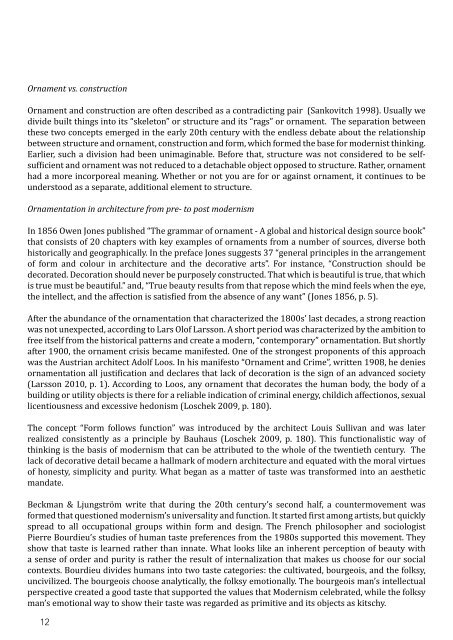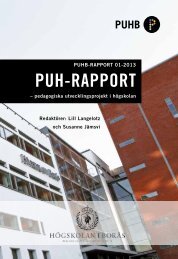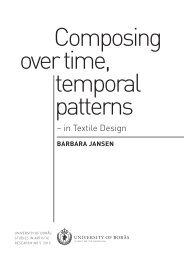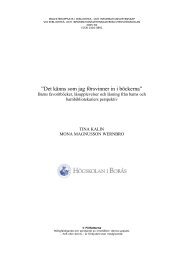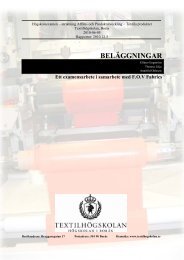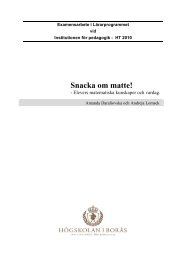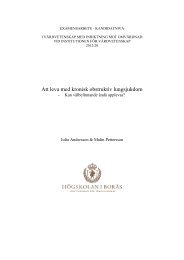KURBITCH! - BADA
KURBITCH! - BADA
KURBITCH! - BADA
Create successful ePaper yourself
Turn your PDF publications into a flip-book with our unique Google optimized e-Paper software.
Ornament vs. construction<br />
Ornament and construction are often described as a contradicting pair (Sankovitch 1998). Usually we<br />
divide built things into its “skeleton” or structure and its “rags” or ornament. The separation between<br />
these two concepts emerged in the early 20th century with the endless debate about the relationship<br />
between structure and ornament, construction and form, which formed the base for modernist thinking.<br />
Earlier, such a division had been unimaginable. Before that, structure was not considered to be selfsufficient<br />
and ornament was not reduced to a detachable object opposed to structure. Rather, ornament<br />
had a more incorporeal meaning. Whether or not you are for or against ornament, it continues to be<br />
understood as a separate, additional element to structure.<br />
Ornamentation in architecture from pre- to post modernism<br />
In 1856 Owen Jones published “The grammar of ornament - A global and historical design source book”<br />
that consists of 20 chapters with key examples of ornaments from a number of sources, diverse both<br />
historically and geographically. In the preface Jones suggests 37 “general principles in the arrangement<br />
of form and colour in architecture and the decorative arts”. For instance, “Construction should be<br />
decorated. Decoration should never be purposely constructed. That which is beautiful is true, that which<br />
is true must be beautiful.” and, “True beauty results from that repose which the mind feels when the eye,<br />
the intellect, and the affection is satisfied from the absence of any want” (Jones 1856, p. 5).<br />
After the abundance of the ornamentation that characterized the 1800s’ last decades, a strong reaction<br />
was not unexpected, according to Lars Olof Larsson. A short period was characterized by the ambition to<br />
free itself from the historical patterns and create a modern, “contemporary” ornamentation. But shortly<br />
after 1900, the ornament crisis became manifested. One of the strongest proponents of this approach<br />
was the Austrian architect Adolf Loos. In his manifesto “Ornament and Crime”, written 1908, he denies<br />
ornamentation all justification and declares that lack of decoration is the sign of an advanced society<br />
(Larsson 2010, p. 1). According to Loos, any ornament that decorates the human body, the body of a<br />
building or utility objects is there for a reliable indication of criminal energy, childich affectionos, sexual<br />
licentiousness and excessive hedonism (Loschek 2009, p. 180).<br />
A page with examples of moresque ornamnets from Owen Jones “The grammar of ornaments” fig. 1. A doorway of Jules<br />
Lavirotte concidered an Art Nouveau masterpiece, fig 2.<br />
The concept “Form follows function” was introduced by the architect Louis Sullivan and was later<br />
realized consistently as a principle by Bauhaus (Loschek 2009, p. 180). This functionalistic way of<br />
thinking is the basis of modernism that can be attributed to the whole of the twentieth century. The<br />
lack of decorative detail became a hallmark of modern architecture and equated with the moral virtues<br />
of honesty, simplicity and purity. What began as a matter of taste was transformed into an aesthetic<br />
mandate.<br />
Beckman & Ljungström write that during the 20th century’s second half, a countermovement was<br />
formed that questioned modernism’s universality and function. It started first among artists, but quickly<br />
spread to all occupational groups within form and design. The French philosopher and sociologist<br />
Pierre Bourdieu’s studies of human taste preferences from the 1980s supported this movement. They<br />
show that taste is learned rather than innate. What looks like an inherent perception of beauty with<br />
a sense of order and purity is rather the result of internalization that makes us choose for our social<br />
contexts. Bourdieu divides humans into two taste categories: the cultivated, bourgeois, and the folksy,<br />
uncivilized. The bourgeois choose analytically, the folksy emotionally. The bourgeois man’s intellectual<br />
perspective created a good taste that supported the values that Modernism celebrated, while the folksy<br />
man’s emotional way to show their taste was regarded as primitive and its objects as kitschy.<br />
Fig 3. Louis Sullivan’s Wainwright Building. The dormitory building of the Bauhaus school in Dressau, fig 4.<br />
12 13


